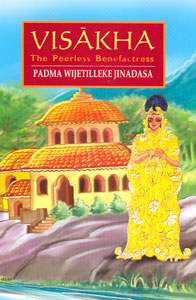Padma Wijetilleke’s contribution to Buddhist literature includes three books written in English easily understandable even by children. They are the abridged versions of Vessantara Jataka titled “The Supreme Sacrifice" the story of Angulimala, titled “Innocence Exploited" and "Visakha, the Peerless Benefactress”.
The authoress who had long experience as an educationist had targetted these for young children. Jataka tales which relate the past birth stories of the Bodhisatta or Buddha Aspirant make interesting reading. They belong to Buddhist classical literature.The Supreme Sacrifice describes how the Bodhisatta born as a prince in the ancient city of Jayatura sacrificed his possessions including the royal elephant in the process of fulfilling the perfection of generosity.
The elephant was the prized possession of the royalty. The people turned against the king for the act of donating the elephant to a neighbouring kingdom by prince Vessantara. To prevent a civil uprising Vessantara voluntarily retired to the forest “Vankagiri” with his wife Madridevi and their two little children.
While leading an ascetic life in the forest he made the supreme sacrifice of handing over his two precious children to an old brahmin whose young wife insisted on making them domestic helpers. The children were later saved by their grandfather. Subsequently the people realized their folly and brought Prince Vessantara back to the kingdom.
The well known story of Angulimala is related in a narrative style by the writer. Ahinsaka was the name of the child born to Bhaggava and his wife. Mantani Bhaggava was the chaplain of king Paenadi of Kosala. The child was sent to Disapamok of Taxila for his education.
Ahimasaka did his studies well, but due to a conspiracy the teacher turned against him and requested him to bring a garland of one thousand fingers collecting one from each person, as an honorarium. Innocent as he was Ahimsaka started collecting the fingers. He thus became a notorious highwayman and earned the nickname “Angulimala" (necklace of fingers). When he was about to kill his own mother, the Buddha intervened. Angulimala was saved from the heinous crime of matricide. He entered the order of monks and later became an Arahant.
The chief female lay disciple of the Buddha was Visakha. Her unblemished character is described in ‘Visakha' in a clear narrative style. Her father Dhananjaya was a millionaire in Saketa. The epitome of feminine virtue, at a very young ageVisakha became a ‘stream enterer’ (Sotapanna) after listening to a sermon of the Buddha.
Visakha’s exceptional beauty attracted the attention of the brahmin advisers of the wealthy merchant Migara who was looking for a bride for his son Punnawardhana. The words of advice given by Dhananjaya to his daughter before her marriage are apt even for a present day bride.
As the chief female devotee of the Buddha, Visakha's generosity could be compared only to that of Anathapindika. As the writer mentions she was a peerless benefactress. She spent an enormous sum on the construction of the Pubbarama monastery for the Buddha. The ‘Melapaladanava' or the ornamental dress she wore when she visited the Buddha was worth millions. The background story of the donation of Pubbarama is succinctly described in this publication
The distinctive feature of these well illustrated books is their beautiful presentation and the clear sequence of events. The stories could be read without a pause. Reasonably priced, these books are available at Sarasavi Bookahops and at the Buddhist Cultural Centre.
|


